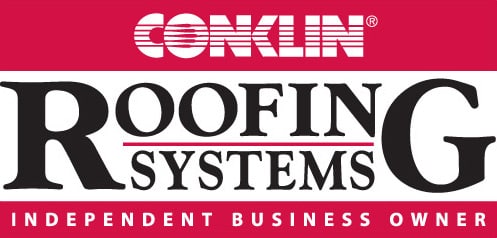Google is always changing the rules of the game. Every couple of months there is a new algorithm update out and there are hundreds of tweaks they are pushing out every day. That’s why it’s more important than ever to be up to the best optimization practices that work now, in 2017.
Not only that, SEO is becoming a scheme in the eyes of the business owners. Most of them were cheated or are still being cheated by an SEO company that takes their money and basically doesn’t do anything
With this post you can quickly check if your guy is using up to date techniques without listening to their excuses, such as “I need more time, we are doing everything we can” etc.
I can talk about SEO all day, write a 5000-word essay on what you should do, but I think it’s much better to just show you on a live example.
In this post you will learn:
- What every Roofing Contractor should have on their website
- 2017 best SEO practices for a roofing website
- Quickly check if your current SEO company is doing a good job on your website
To put it simply… You can use this example as a benchmark for your website. I’ll break it down with explanations on how you can check if you have all the proper elements on your website.
Don’t get cheated by an SEO company ever again
About the website example
Let’s take a roofer from Tulsa Oklahoma: Ranger Roofing of Oklahoma
Their focus is residential roofing, gutters, insurance claims and emergency roof repairs. That being said, the biggest mistake marketing companies are doing is that they are trying to rank the homepage rangerroofingok.com for all the keywords combination:
- Roofing contractor tulsa
- Roofing tulsa ok
- Roofing company tulsa
- Residential roofing tulsa
- Roof repair tulsa
- Gutter installation tulsa
- emergency roofing repair tulsa, ok
- and every other possible combination
The main problem with this approach is that you dilute your home page relevancy. Google doesn’t know what to rank for. It can work in a short term, but with every Google update, you can expect massive keyword fluctuations as Google is focusing more and more on relevancy.
You want your home page to rank for the toughest keywords, such as roofing + city, roofing contractor + city, and all the variations and your service pages should rank for their keyword variations.
Example:
Roof repair page – rangerroofingok.com/roof-repair/
- Roof repair + city
- Roofing repair + city + state
- roof repair contractor + city +state
Gutters – rangerroofingok.com/gutters/
- Gutters + city
- Gutter installation + city
- gutter company + city + state
Now, let’s dissect the page per page most important signals:
Most important on-page signals that every website and every page should have
- Meta title – this is what you see in Google search as a title
- Meta description – this is what you see in Google search as a description
- Headings tags
- Schema
- Image optimization
- Website speed
Homepage
Like I said before, your homepage should target your most difficult keywords. You need to have your keywords in your meta title, meta description, image alt tags and headings tags.
Understanding Meta title and Meta description

You probably know about the character limit for your Meta information. You have 50-60 character limit for your Meta title and 170 characters for your Meta description (for those who don’t know what are Meta title and description: it’s the text you see in Google when you are searching for something)
You need to have your main keywords (for the page you are trying to rank) + call to action. Why should people click on your search result and not on your competition?
You can use a call to action, such as:
- BBB A+ accredited
- Free Roof Inspection
- X number of years in business
Home page Meta title tag:
Roofing Contractor in City, State Abbreviation | call to action | business name
Roofing Contractor Tulsa , OK | Free Roof Inspection | Ranger Roofing Of Oklahoma
Note: If your webpage’s Meta titles are longer than 50 characters, that’s ok. You need to have your business name in your title so that Google can associate your business name with that keyword. That’s super important if you want to rank in the Google maps section.
Remember, in Google maps basically you are ranking your Business name, so you need to associate the keywords with your name.
About us title tag – (Business name) is the top roofing contractor in (city name)
Contact page – Contact an Roofing company Tulsa Today – Ranger Roofing of Oklahoma
How can you check your Meta titles and Meta descriptions
You can use this side by side comparison tool:
https://www.internetmarketingninjas.com/seo-tools/seo-compare/
Put your main pages in the box and check the information
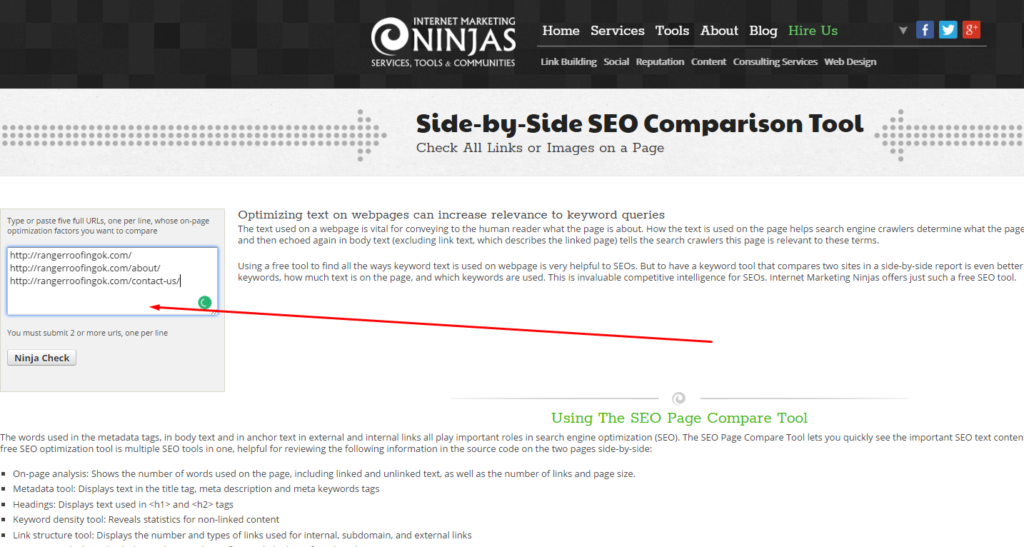
Wait a couple of seconds and check your Meta info

I’m not saying you need to have the same Meta information like shown above.
What you need to have is:
- Your keywords
- Business name
- Nice call to action
Meta description
On the same page, you can check your Meta description info. Again, you need to have your keyword, brand name, and call to action in it.
Note: Don’t copy the same keyword you used in your title.
If you used roofing contractor + city, try roofing company + city or just roofing + city.
You want to use as many keywords as you can. Once again, this is why you never want to rank your home page for all the keywords you are trying to rank. It will be difficult to rank the home page for metal roofing + city or gutter installation + city if you are not mentioning them anywhere in your title or description.
I’m not saying it’s not possible, it’s just harder and you are opening yourself for a disaster with every Google algorithm update.
Let’s talk about headings tags.
Heading tags, as the name implies, are tags that are used for the creations of headings. The most important tag is the <h1> heading tag, and will usually be the title of a post. Heading tags have a top-down hierarchy from <h1> to <h6>.
On your page, you can have headings from h1 to h6. H1 being the most important tag, however getting h1-h3 down and working together gives you a huge advantage over the competition.
Most common mistakes with heading tags
One of the biggest problems that most websites suffer from, is bad coding and having more than 1 unoptimized heading tag.
You should only have ONE h1 tag, but you can have multiple h2, h3 tags on your page.
When I say bad coding, I mean that people who designed your website use those heading tags for certain design elements, so it’s easier for them to style your website. They don’t care if the website is going to rank and bring you a return on your investment.
How to check your headings tag
Use the same tool: Side by side comparison
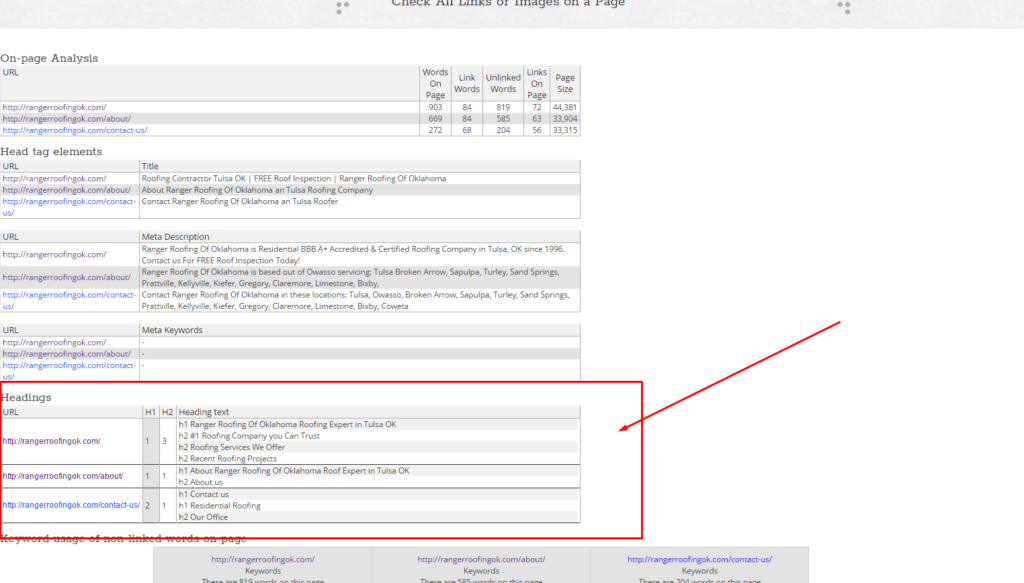
How you optimize your heading tags, depends on how you optimized your title tag and your URL.
To keep things as simple as possible.
- Don’t use your h1 tag as your Meta title
- Use a variation of your keyword + city + business name
For h2,h3… tags
Us a variation of your keyword, but don’t use the city name. You don’t have to repeat your city name too many times. That was working a couple of years ago, now Google is smarter than that.
Use your city name in your title and your h1. Everywhere else just use variations of your keywords
Other service pages
The same advice for the homepage also applies to the rest of the pages on your website
- Roof repair + city | call to action | brand name
- Gutters + city | call to action | brand name
- Roof Replacement + city | call to action | brand name
- Metal roofing + city | call to action | brand name
- Commercial roofing + city | call to action | brand name
- Residential roofing + city | call to action | brand name
Let’s talk about website speed
Website loading speed is super important for the user experience and it has a direct impact on your rankings. People don’t want to wait for your page to load and Google doesn’t want to rank websites that take forever to load.
How to check your website speed
There are a lot of tools that can do that for you. I mainly use Google page speed insight (it’s Google product, so we want to make him happy) and Pingdom speed test to see the actual number
https://developers.google.com/speed/pagespeed/insights/
You want to get at least 70/100 on Google page speed insight, and below 2 seconds on the Pingdom speed test.
How to optimize your images
Optimizing your images is not a science. Most companies don’t optimize them because they are lazy.
- You want to have at least one or two images per page you are trying to rank.
- They need be named properly before uploading, and you need to add the alt tag before publishing.
Example
Name them before uploading
Roofingcontractortulsa.jpeg
Not
Homepageimage.jpeg
In the alt tag put something descriptive: quality roofing contractor Tulsa, Oklahoma.
Google schema
Using Google schema on your website is like using Google language on your website. Schema is a markup code that you put on your website to tell Google exactly who you are, where you are and how can people contact you.
You need only 10 min to set it up, and most websites still don’t have them because people are lazy.
With schema you can markup your basic contact info and tell Google your:
- Business name
- Address
- Phone number
- Link to your social media accounts
- Your exact geo coordinates
- Link to your google maps profile
- Working hours
- And more
Checking if your website has schema is the best way to determine if your marketing guy is using 2017 marketing strategies.
All you need to do is go to this page and input your website url:
https://search.google.com/structured-data/testing-tool/u/0/
If you have schema, you’ll get this roofing contractor tab or Organization tab.
If you don’t have it, it will be blank:
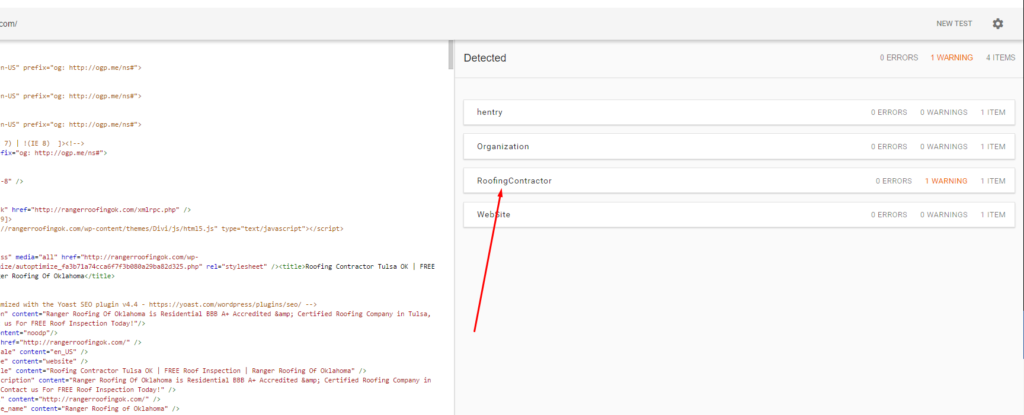
This is how Google schema looks like:
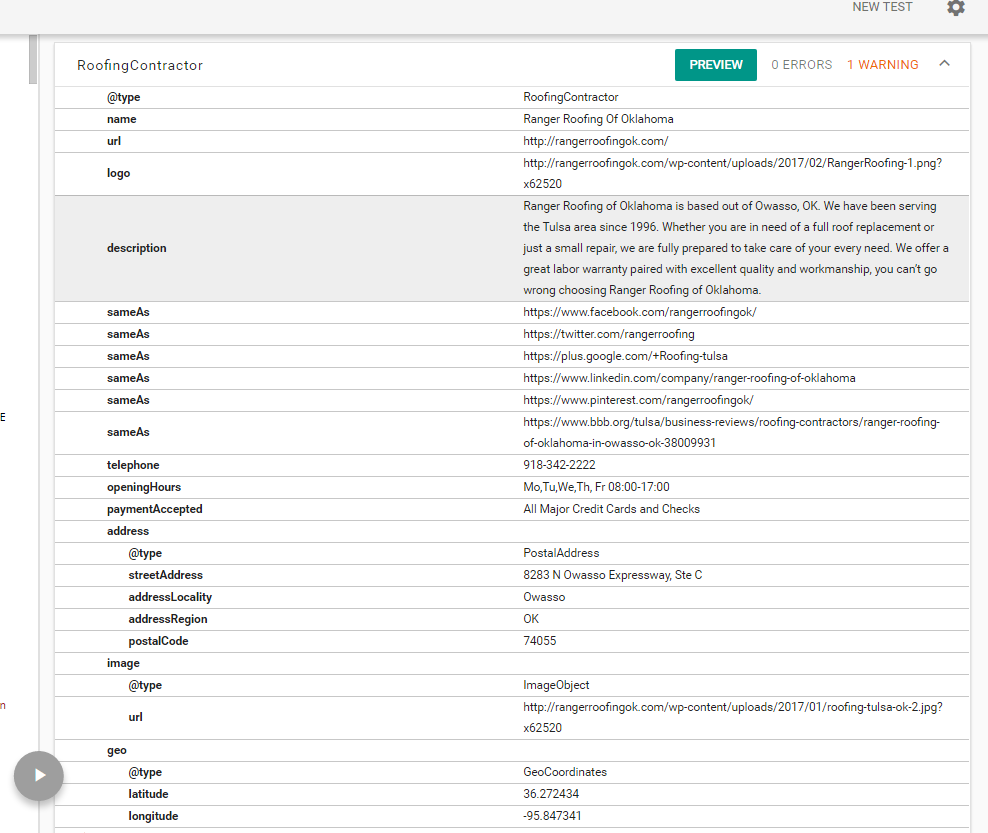
That pretty much sums it up. There are many more technical things that go into proper on-page SEO, but I wanted to keep things as simple as possible. The point of this article is not to educate you so you can do it by yourself (even though you have a nice template). It’s for you to check your current marketing company performance. You can also use it while negotiating with other SEO companies. If you ask them if they know what is Google schema is and what should be placed in it, and their answer is negative, you’ll know that they are not the best company to work with in 2017.
If you have any doubts, questions or concerns about any aspect of the SEO or your website, feel free to drop a comment below.
[starbox]
